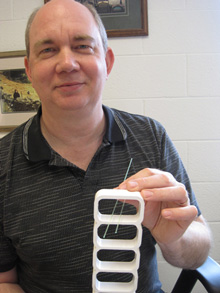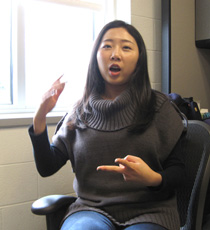Neutrinos … and why we study them at William & Mary
Neutrinos are interesting to physicists for some of the same reasons that pottery shards are interesting to archaeologists. Just as archaeologists study broken clay pieces to construct a story about the society that produced them, physicists examine neutrinos to learn more about the events and processes from which these sub-atomic particles have their origins.
 The Big Bang produced neutrinos—particles that are still zooming through space yet today. Atomic power plants produce neutrinos. The fusion furnace of our sun pumps out neutrinos. When a star goes supernova, the process generates an enormous spurt of neutrinos.
The Big Bang produced neutrinos—particles that are still zooming through space yet today. Atomic power plants produce neutrinos. The fusion furnace of our sun pumps out neutrinos. When a star goes supernova, the process generates an enormous spurt of neutrinos.
There is more to neutrinos than the detritus of reactions; they are interesting little things in their own right. They almost never interact with matter, a property that makes neutrinos a challenge to study. They come in three “flavors”—electron, muon and tau. They oscillate—change flavors— in midflight. Fermilab explains oscillation by asking us to imagine a sports car, changing into a bus or minivan as it goes down the highway, then changing back to a sports car. It gets even more complicated: Neutrinos have mass, but the mass and the flavors don’t necessarily correspond. Particle physicists talk about “mixing” to describe the weird morphing of neutrino masses and flavors; the mixing phenomenon is the focus of many neutrino experiments.
Physicists have long understood that the path to learning more about just any aspect of energy or matter leads, sooner or later, through a cloud of these mysterious and ubiquitous subatomic particles. Scientists have learned a lot about stars (including our own sun) by studying neutrinos, and there is a lot more to learn about the cosmos. Want to understand galaxy clustering? Interested in why the universe is dominated by matter? It doesn’t matter; understanding how neutrinos operate is essential to taking any number of next steps in new physics.
Because these subatomic particles are so important on so many levels, there are many neutrino experiments going on and William & Mary physicists are involved in a number of them. For instance, William & Mary physicists Robert McKeown and Wei Wang collaborate with scientists at the Daya Bay neutrino experiment in China, helping to nail down a key measurement, known as the “mixing angle” θ13, pronounced “theta one-three,” in 2011.
In the U.S., the Department of Energy’s Fermi National Accelerator Laboratory outside Chicago is home to a number of neutrino experiments and therefore home away from home for some of William & Mary’s physicists. Three of the current neutrino experiments at Fermilab—MINOS/MINOS+, MINERvA and NOvA—examine different properties of neutrinos emitted by a common source, the NuMI beam.
Patricia Vahle, associate professor of physics, is spending a year at Fermilab as an Intensity Frontier Fellow and her post-doctoral researcher, Alex Radovic, is resident at Fermilab. Vahle is one of a group of William & Mary physicists working on NOvA, which made the news in February after the scientists saw neutrinos even before they were finished building the experiment apparatus.
“We certainly expected to see neutrinos—and we’re seeing them where we expected to see them,” Vahle said. “I personally am a little surprised that we were able to find them in as small a section of the detector as we did.”
Like most neutrino experiments, NOvA has three components. A particle accelerator sends a beam of neutrinos (known as the NuMI beam) aimed at two detectors, one near and one far. NOvA is what physicists call a long-baseline experiment because the neutrino beam must travel some 500 miles to the far detector in Ash River, Minnesota. A near detector, the third component, is located at Fermilab.
“We always have a detector close by, so we can figure out the properties of the neutrino beam and how the detectors work before any oscillations happen,” Vahle explained. “Then we look in the far detector to uncover the oscillation properties.”
Both detectors are constructed of layers of PVC channels, filled with mineral oil, creating a favorable environment for seeing neutrinos interact. A neutrino is detected by the charged particles that result when one collides with an atom of the mineral oil, doped with fluorescing molecules to create a scintillator. The bit of light that results from this collision is collected by optical fiber in each channel and recorded.
The difference between the detectors is one of size. The finished far detector will measure around 15 x 15 x 78 meters. Jeffrey Nelson, associate professor of physics, another NOvA collaborator, says that the far detector will be the largest plastic structure in the world. Vahle said that the news-making February neutrinos were showing up in the far detector when it was only about 15 percent constructed.
 Vahle has been working on various aspects of NOvA since 2008, including calibrations and prototyping and, most recently, working to commission the far detector. Ji Liu, Vahle’s Ph.D. student, spent the fall semester working on a couple of important tasks related to the assembly of the near detector.
Vahle has been working on various aspects of NOvA since 2008, including calibrations and prototyping and, most recently, working to commission the far detector. Ji Liu, Vahle’s Ph.D. student, spent the fall semester working on a couple of important tasks related to the assembly of the near detector.
“For the near detector we have a module that’s a combination of many cells, which will be filled with scintillator eventually,” she explained. “We need to make sure it doesn’t leak, so we put air into the PVC cells and test the pressure.”
Actually, Liu was double-checking the modules, as they had already been pressure tested before being shipped to Fermilab. Even so, she found three out of the more than 200 modules were bad. She rechecked the modules for pressure again after the assembly. Her other job was to label all of the components.
“That doesn’t sound like a very important job, but it was quite useful to me, because it required that I get a full understanding of the whole construction of the detector,” she said.
When Liu came back to Williamsburg, Marco Coló, a Ph.D. student of Nelson’s, took her place at Fermilab, working on the near detector.
Nelson’s involvement with the NOvA project goes back ten years, to a set of meetings at Stanford to discuss new directions in neutrino research. NOvA is just one of a number of experiments that came out of the discussions.
“These are all what we call “superbeam” experiments: Envision a beam, and then make it better,” he said. “Put more power into it and get more neutrinos and get better statistics to look at more rare effects.”
He said that NOvA will use the same beam that is used in the ongoing MINOS/MINOS+ and MINERvA experiments at Fermilab. William & Mary physicists are involved in all three of the experiments and Nelson, Vahle and Associate Professor of Physics Michael Kordosky have received considerable outside funding—including more than $2.5 million from the National Science Foundation—for their part in the neutrino studies.
Nelson is a collaborator in MINOS and MINERvA as well as NOvA. Vahle is involved with MINOS as well as NOvA. Kordosky is not working on NOvA, but is a collaborator on the other two experiments. He is a long-time MINOS collaborator, having written his Ph.D. thesis on interactions in the experiment’s detectors. He expanded on his thesis after joining the William & Mary faculty and his work pointed the way for MINOS collaborators to fine-tune their analyses of neutrino oscillations.
Each of the experiments is designed for a specific set of purposes. For example, Nelson explained that MINOS detector is steel, designed to detect particles called muons that are the result of muon neutrino interactions and which travel meters of distance in steel.
By comparison, NOvA is a more “fine-grained” experiment. He explained that NOvA’s detectors, with their PVC structure, are 75 percent scintillator and therefore designed so that the physicists can see details left by electrons, which travel much shorter distances than muons.
Vahle and Nelson both are optimistic about NOvA’s auspicious beginning. Nelson says the appearance of neutrinos in the first modules of the unfinished far detector is like catching fish before you have all your lines cast out.
Fermilab expects the far detector to be completely assembled by spring and fully operational by summer. NOvA is expected to run for six years and to record some 5,000 neutrino interactions, most of which, Nelson says, will be “boring old muons,” but everyone is hoping for a healthy presence of electron neutrinos, which have oscillated in midflight from the muon neutrinos .
The future holds more neutrino experiments—and more collaboration by William & Mary physicists. McKeown and Wang are involved in the development of the Long-Baseline Neutrino Experiment (LBNE). Kordosky is scheduled to join the LBNE project which is scheduled to begin in 2022, with a detector in South Dakota catching neutrinos emitted from Fermilab, more than 800 miles away.
Nelson and Vahle are working on CHIPs, a proposed experiment to build a cost-effective neutrino detector in a flooded mine pit in Minnesota that conveniently lies in the path of the NuMI beam. Kordosky’s also a collaborator on LAriaT, an initiative to use liquid argon detectors that involves Vahle and Kordosky.
Just as Small Hall sends physicists out into the world of neutrino research, the neutrino world also comes to William & Mary: The university’s physicists hosted NuFact 2012, the annual workshop dedicated to neutrino study, which brought 150 of the world’s leading particle physicists to Williamsburg. Skip to main content
Skip to main content


